
Arriving in a new city should feel exciting, not stressful. Yet for many travellers, the first hurdle is the airport transfer: how quickly, easily, and affordably you can get from the terminal to the places you want to be.
To help, we analysed the world’s 50 most visited cities and ranked them by how convenient they are for arrivals. We looked at what really matters when you first land:
•Exclusive Mozio data on the estimated transfer time from the city’s busiest airport to a central landmark
•Public transport times and frequency to the town
•Estimated taxi fares for a direct ride
•Transit coverage showing how much of the population lives near rapid transport
•Amenities such as hotels, restaurants, cafés, and bars
•Average three-star hotel price for an overnight stay
These give a clear picture of the cities where airport transfers are smooth, onward travel is straightforward, and where you can settle in without the stress.
Landing somewhere new can feel overwhelming. With Mozio, you can compare every option for airport transfers all in one place. No stress, no guesswork, just a smooth start to your trip.
Book now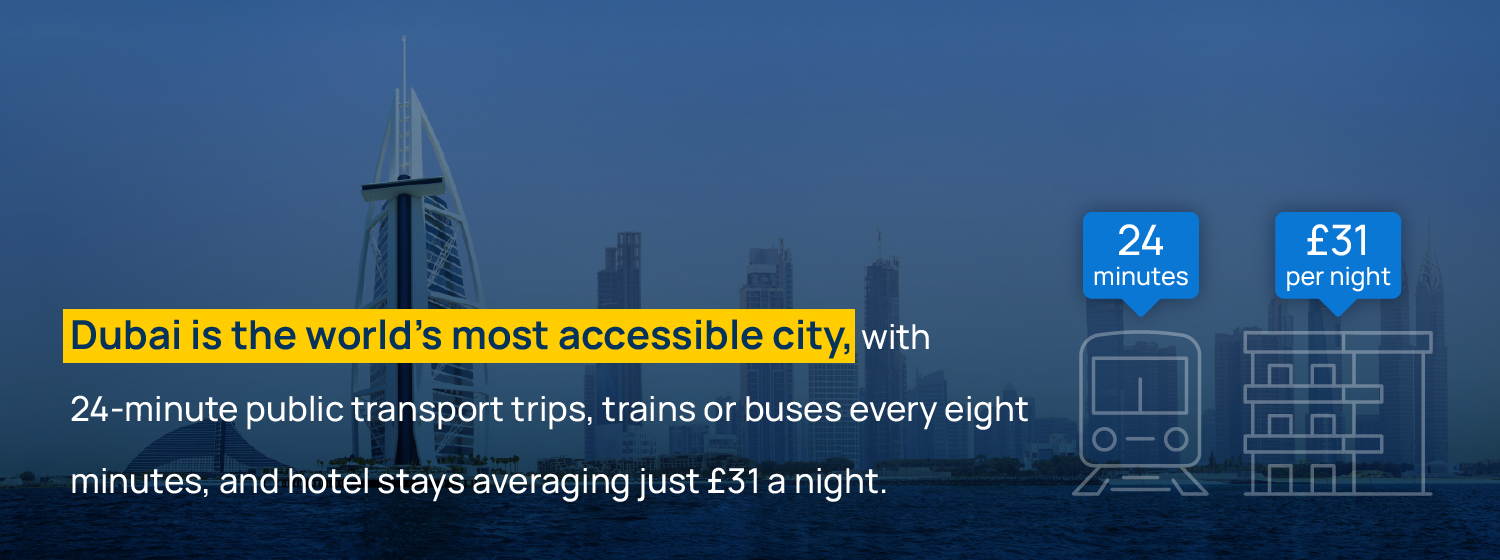

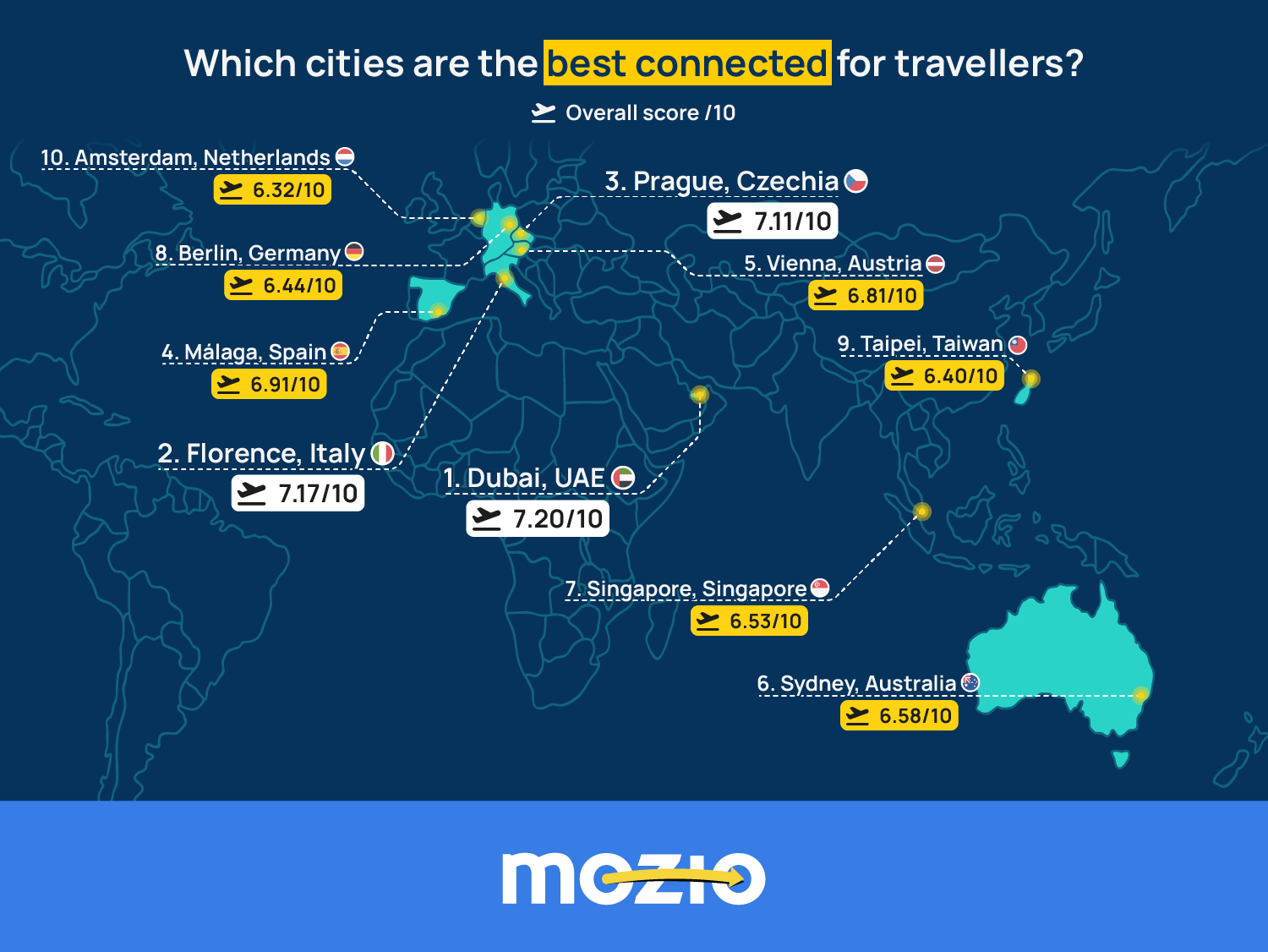
There’s nothing better than stepping off a flight and knowing the city is within easy reach. In these destinations, you can drop your bags, freshen up, and be out exploring in no time.
These destinations make arrivals easier, combining short transfers, reliable transport, and plenty of amenities to welcome you once you’re there.
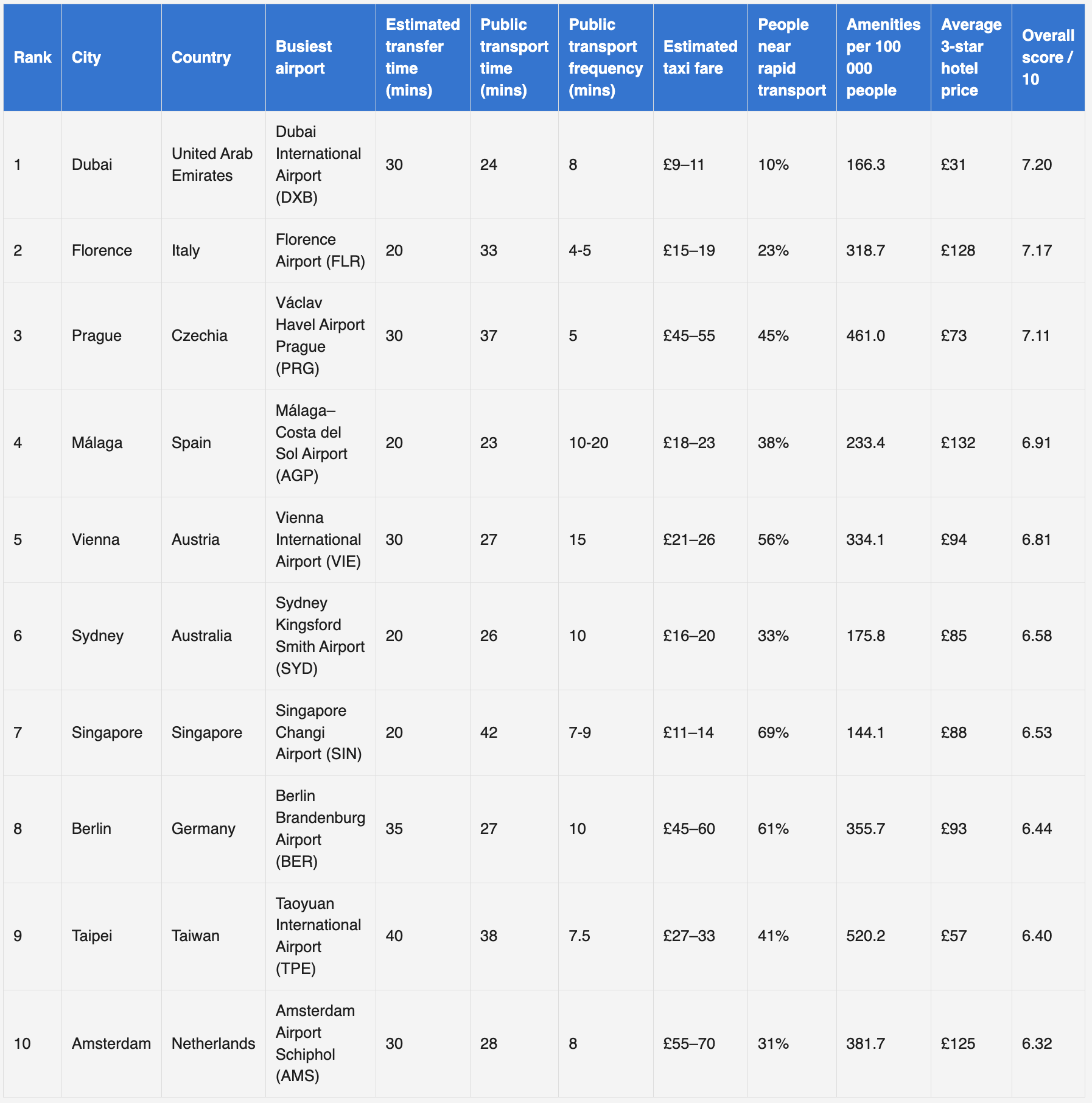
Few global hubs make it as easy – or as affordable – to reach the city as Dubai. Dubai International Airport (DXB) has an estimated Mozio transfer time of 30 minutes, meaning you can move from baggage claim to the heart of the city with minimal delay. Public transport options also run every eight minutes on average, meaning travellers rarely face long waits.
For those staying overnight, accommodation is remarkably budget-friendly for a major hub. Three-star hotels average just £31 per night, freeing up more of your travel budget for exploring. With a density of over 166 amenities per 100,000 residents, Dubai offers plenty of restaurants, cafés, and bars to discover once you arrive.
Avoid the hassle of figuring out transport on arrival. With Mozio, you can compare taxis, metro links, and shuttle services to downtown Dubai, choosing what suits your time, budget, and comfort best.
Book your Dubai transferTouch down in Florence and you’re only minutes away from the city’s historic heart. Peretola Airport (FLR) has an estimated Mozio transfer time of 20 minutes, making it one of the quickest connections in the index. Travellers can expect to be in the heart of Tuscany in just over half an hour, with public transport running every four to five minutes – far more frequent than in many larger capitals.
The city itself feels tailor-made for visitors. With more than 318 amenities per 100,000 residents, Florence has a rich density of cafés, restaurants, and bars. It means you’ll never have to wander far for a morning espresso or a late-night glass of Chianti.
Arriving in Prague is refreshingly straightforward, and what makes the city stand out is how well it’s set up for visitors:
Václav Havel Airport (PRG) has an estimated transfer time of 30 minutes, getting you to Old Town Square without too much hanging around. Trains and buses also usually leave every five minutes, so even if you just miss one, you won’t be waiting long for the next.
When you’ve just landed, every minute between the terminal and the city centre counts. The cities below keep transfer times short and straightforward, with public transport journeys taking under half an hour.
Less time in transit = more time exploring.

In both Málaga and Tokyo, travellers can get from the airport to the city centre in just 23 minutes. From Málaga–Costa del Sol Airport, this short ride brings you straight into Plaza de la Constitución, while Tokyo’s services zip passengers from Haneda Airport into Tokyo Station with the same efficiency.
For visitors, that means less time in transit and more time to enjoy the city. Within an hour of landing in Málaga, you could be strolling along the waterfront or dipping into tapas bars, while in Tokyo, you could be exploring bustling Shibuya or heading straight for a business meeting in the city centre.
When landing in a new city, the last thing you want is to stand around waiting for a bus or train. Frequent services make airport transfers faster and far less stressful, helping you reach your hotel, meeting, or first stop without delay.

In Prague and Delhi, public transport runs like clockwork, with services usually leaving the airports every five minutes. Even if you’ve just missed a bus or train, another one is close behind – ideal when you’re juggling luggage or travelling late at night.
This level of frequency helps keep journeys stress-free. In Prague, those services link you to Old Town Square in just over half an hour, while in Delhi, they take travellers straight into the heart of the city in about 43 minutes.
Whether you prefer the speed of a direct taxi or the value of public transport, Mozio helps you see every option and book what works best for your trip.
Book your ride nowSometimes, the simplest option after landing is to jump in a taxi. In these cities, fares are so low that the ride into town barely dents your budget; they’re a stress-free choice if you’re tired after a long flight or arriving late at night.
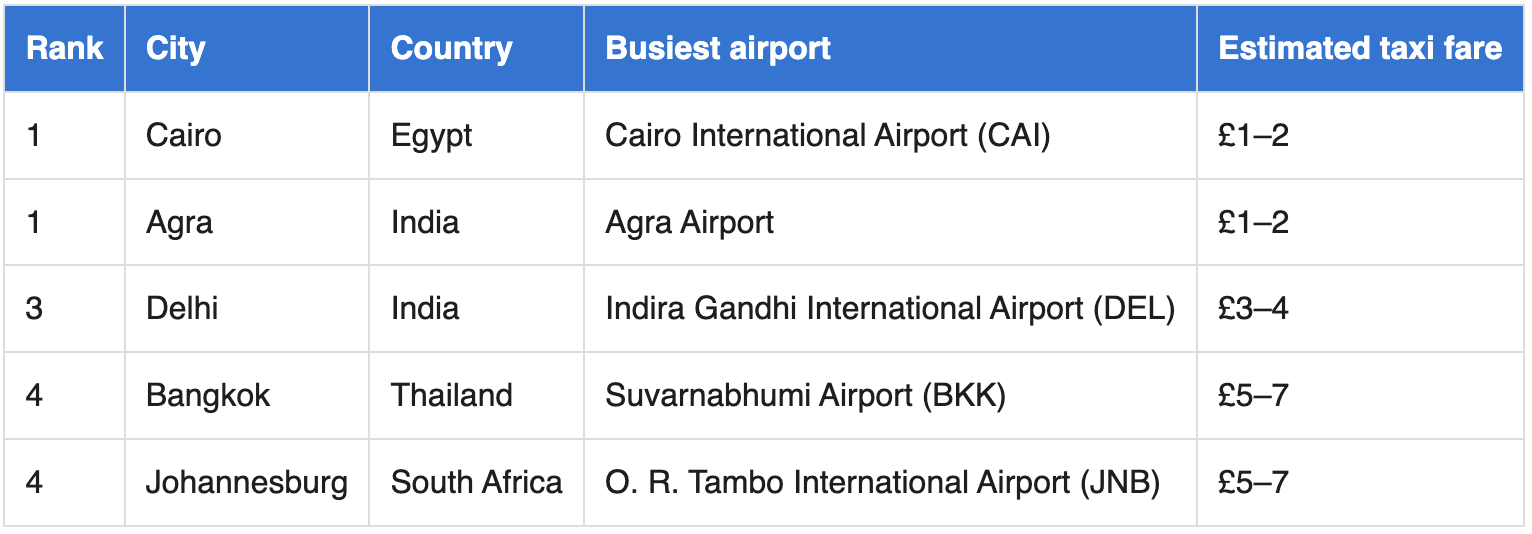
Cairo International Airport and Agra Airport offer taxi journeys into the city centre for as little as £1 to £2, making it the most affordable transfer in the entire study. To put that in perspective:
A low fare like Cairo’s makes it easy to opt for a taxi, knowing you’ll still have plenty left to spend once you reach the city. In Cairo, that means more of your budget can go toward the Pyramids of Giza, the Egyptian Museum, or a street food feast downtown. In Agra, the savings leave more room for once-in-a-lifetime experiences like visiting the Taj Mahal or exploring Agra Fort.
With Mozio, you can compare and book licensed taxi providers at transparent prices, so there are no surprises when you reach the city.
Book your transferGetting into the city is only the first step of your journey. Once you’ve arrived, a reliable metro or rail system makes it easier to explore, whether you are heading to a business meeting or sightseeing across town.
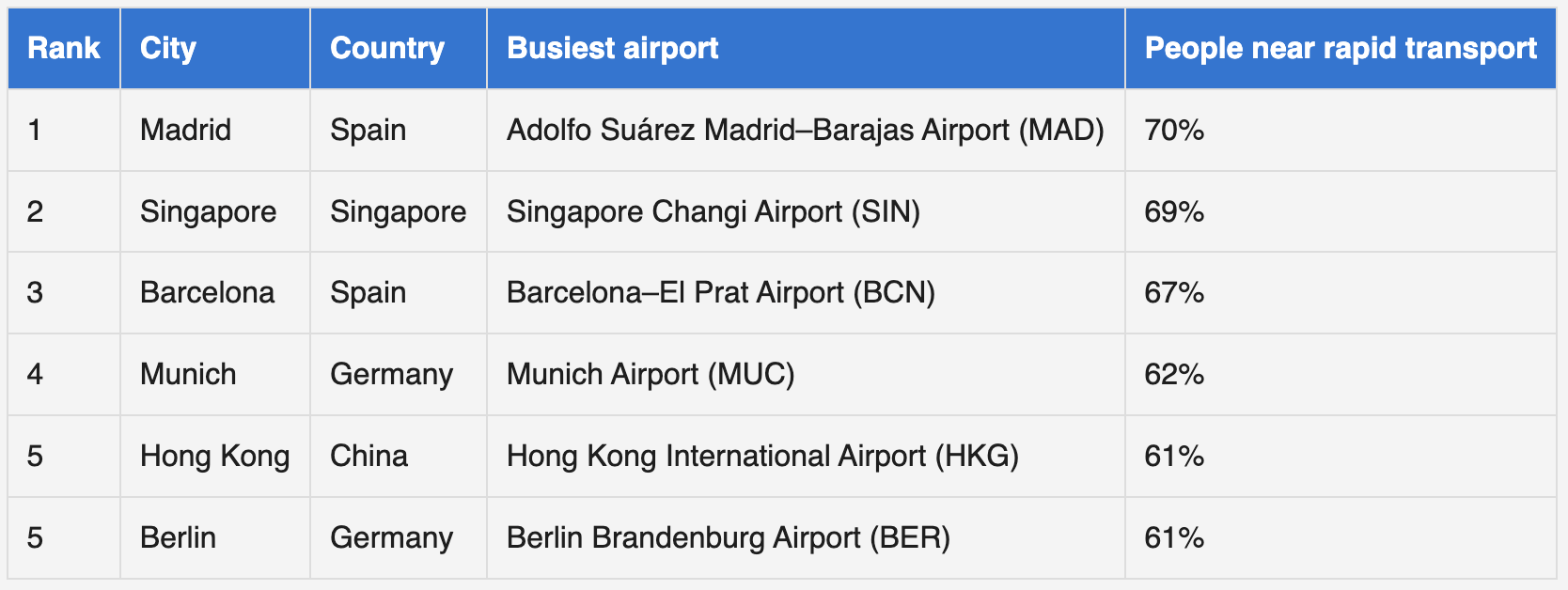
In Madrid, seven in 10 (70%) residents live close to rapid transport, giving the city one of the most extensive networks in the world. For visitors, that means a metro system that feels accessible wherever you are staying, with stations well-placed for hotels, business districts, and tourist hotspots.
The coverage also makes it simple to move beyond the centre. You can catch the metro out to neighbourhoods like Malasaña for tapas, Chamartín for business, or even connect easily to the airport for your flight home. With such widespread access, Madrid’s transport system takes the stress out of navigating a busy European capital.
Mozio is a global ground transportation search engine that helps travellers compare and book everything from taxis and shuttles to trains, limousines, and even water taxis. Whether you are travelling for business or leisure, Mozio’s mission is to make airport transfers and onward journeys as simple and stress-free as possible.
With that in mind, we created the Global City Access Index to find out which destinations make arrivals easiest for visitors. We ranked the 50 most visited cities in the world according to Euromonitor data on the following accessibility and convenience factors.
Note: Some locations were removed due to current political sensitivities.
1. Estimated transfer time
The estimated transfer time (in minutes) using Mozio. The recommended transfer option was used from the city’s busiest airport (by passenger numbers) to a central landmark (e.g. main square, train station, or recognised city centre point).
2. Public transport time
The public transport transfer time (in minutes) from the airport to the same central point was sourced from Google Maps. For each city, we took the shortest journey shown when searching at 12:00 p.m. local time on a weekday.
Cities without a public transport option were scored slightly worse than cities with the longest actual time. These times may include short walks to/from the station and wait times for connections.
3. Public transport frequency
The public transport frequency (in minutes) for the main rail, metro, tram, or express bus service was sourced from official airport websites, operator timetables, or other local transport sites.
Cities without a public transport option were scored slightly worse than cities with the longest actual frequency.
4. Taxi cost
The estimated taxi cost from the busiest airport to the city centre was sourced using Rome2Rio. For scoring purposes, an average was calculated from the min-max ranges presented.
5. Transit quality (accessibility to rapid transport)
The percentage of the population near rapid transit was sourced from the Atlas of Sustainable City Transport as a measure of general urban transport quality.
6. Amenities
The number of hotels, restaurants, cafés, bars, and pubs within city boundaries was sourced using OpenStreetMap and calculated per 100,000 residents using population data from World Population Review.
7. Accommodation prices
The average nightly price of a three-star hotel in each city was sourced from Booking.com.
Each metric was normalised into a score out of 10, and an average of these scores was taken, with each factor given equal weight.
All data was collected in September 2025 and is correct as of then.